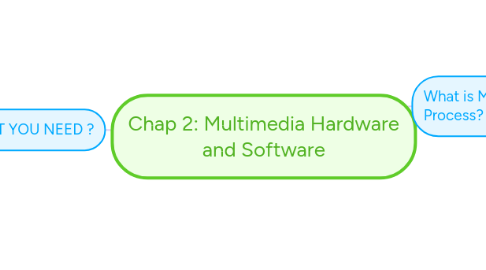
1. WHAT YOU NEED ?
1.1. 1. The Intangibles:
1.1.1. Intangible assets in Multimedia:
1.1.1.1. a. Creativity
1.1.1.1.1. - Creative implies knowledge of hardware & software. - Most precious asset
1.1.1.2. b. Organization
1.1.1.2.1. - organized outline detailing the skills, time, budget, tools, and resources for project.
1.1.1.3. c. Communication
1.1.1.3.1. -workgroup and client is essential
1.2. 2. Multimedia Skills
1.2.1. a. Explain: project involves a lot of people to be produced
1.2.2. b. eg: Each person has their own specialized skills required to do specific task.
1.2.3. c. Main roles in team :
1.2.3.1. 1. Project Manager
1.2.3.1.1. -leader of a project
1.2.3.1.2. -oversee the entire project
1.2.3.2. 2. Multimedia Designer
1.2.3.2.1. -the overall content project
1.2.3.2.2. - design elements required to support that structure.
1.2.3.3. 3. Interface Designer Writer
1.2.3.3.1. - designing each screen / page interface
1.2.3.4. 4. Writer
1.2.3.4.1. -Create characters .
1.2.3.4.2. - Write text screens to deliver message.
1.2.3.5. 5. Audio/Video Specialist
1.2.3.5.1. - Focus: audio and video production - eg : shooting/ capturing and editing video/ digitizing/ audio recording.
1.2.3.6. 6. Multimedia Programmer
1.2.3.6.1. - integrate elements project using programming language.
1.3. 3. Hardware
1.3.1. 1. Production platforms
1.3.1.1. - significant platforms for producing and delivering multimedia projects -eg: Macintosh operating system and Microsoft Windows.
1.3.2. 2. Windows vs. Macintosh
1.3.2.1. eg 1 : Microsoft windows (software company)
1.3.2.1.1. - run on assemblages of hardware from countless manufacturers.
1.3.2.2. eg 2: Apple (hardware manufacturing company )
1.3.2.2.1. -developed own proprietary software to run the hardware.
1.3.2.2.2. - produces both computer and operating system.
1.3.2.3. - Multimedia project development = Macintosh (smoother and easier) than > >Windows
1.3.3. 3. Connections
1.3.3.1. a. Integrated Drive Electronics (IDE)
1.3.3.1.1. - standard interface connect: motherboard >to> storage devices
1.3.3.2. b. Universal Serial Bus (USB)
1.3.3.2.1. - connection used to connect a computer to devices - plug-and-play interface
1.3.3.3. c. FireWire (IEEE 1394)
1.3.3.3.1. - connect devices to personal computer.
1.3.3.3.2. - Introduced by Apple (1980s)
1.3.3.3.3. - single plug-and-socket connection (up to 63 devices).
1.3.3.4. d. Memory and storage devices
1.3.3.4.1. Explain: - Sufficient memory/ storing and archiving files. - project’s content and scope
1.3.3.4.2. 1. ) 2 Types of Memory
1.3.3.4.3. 2. )Hard disks
1.3.3.4.4. 3. ) Flash or thumb drives
1.3.3.4.5. 4. ) CD-ROM
1.3.3.4.6. 5. ) DVD
1.3.3.4.7. 6. ) Blu-ray discs
1.3.3.4.8. 7.) 2 Types of Devices
1.4. 4. Software
1.4.1. 1. Text editing and word processing tools
1.4.1.1. Microsoft Word & Word Perfect (powerful applications) : 1. spell checkers 2. table formatters 3. prebuilt templates for letters 4. resumes 5. purchase orders 6. other common documents.
1.4.1.2. eg: OpenOffice:
1.4.1.2.1. -free, downloadable word processing program.
1.4.2. 2. OCR software
1.4.2.1. -probability and expert system algorithms - bitmapped characters into electronically recognizable text - accurate and saves time and effort
1.4.3. 3. Painting and drawing software
1.4.3.1. a. 2 Types of Tools
1.4.3.1.1. 1. Painting tools: (allow to create and modify bitmap images)
1.4.3.1.2. 2. Drawing tools: (allow to create and modify vector graphics)
1.4.3.2. b. Vector graphics
1.4.3.2.1. - used by Adobe Flash to reduce download time & scaling problems with web graphics.
1.4.3.3. c. features
1.4.3.3.1. Painting and drawing software 1. An intuitive graphical user interface 2. Scalable dimensions 3. Multiple undo capability 4. Scalable text font support 5. Support for third-party special effect plug-ins 6. Layering capability
1.4.3.3.2. Painting features : - smoothing coarse-edged objects into the background with anti-aliasing.
1.4.3.4. d. others software tools
1.4.3.4.1. 1. Image editing tools
1.4.3.4.2. 2. Sound editing tools
1.4.3.4.3. Animation, video, and digital movie tools
1.5. 5. Authoring Systems
1.5.1. a. authoring tool :
1.5.1.1. 1.) EXPLAIN: -software package which allow developers
1.5.1.2. 2.)EG: - Organize and edit the multimedia elements -Design screen layouts(interface) using templates -Create interactivity -assembling diverse multimedia elements into a single, cohesive product.
1.5.1.3. 3.) 3 Types
1.5.1.3.1. 1. Card- and page-based authoring tools
1.5.1.3.2. 2. Icon- and object-based authoring tools
1.5.1.3.3. 3. Time-based authoring tools
1.5.1.4. 4. Objects
1.5.1.4.1. Generally treat multimedia elements =objects: - Each object - assigned properties or modifiers. - Objects - contain scripts that specify a related action.
1.5.1.5. 5. 5 Choosing an authoring tool
1.5.1.5.1. 1. Editing and organizing features
1.5.1.5.2. 2. Programming features
1.5.1.5.3. 3. Interactivity features
1.5.1.5.4. 4. Performance tuning and playback features
1.5.1.5.5. 5. Delivery, cross-platform, and Internet playability features
1.5.2. b. Delivery features
1.5.2.1. 1. ) run-time/ stand-alone version : - allows a project to be executed without authoring software 2.) Run time version: - not allow user to access and change the contents.
1.5.3. c. Cross-platform and
1.5.3.1. - facilitate easy transfer across platforms - EG: from Macintosh to Windows).
1.5.4. d. Internet-playability features
1.5.4.1. -converting output to be delivered within the context of HTML/ DHTML.
2. What is Multimedia Development Process?
2.1. EXPLAIN: Multimedia & web project must be undertaken in stage.
2.2. 4 Basic stages in Multimedia:
2.2.1. 1. Planning & costing:
2.2.1.1. a.) Define the objective & scope: - time to develop and knowledge skill.
2.2.1.2. b.)Target users: - whom project created -background research.
2.2.1.3. c.)Set the contents: -determine the size of the project. - rights to use existing resources. -digitizing picture, audio ,video.
2.2.1.4. d.) prepare time estimate & a budget.
2.2.1.5. e.) prepare a short prototype or proof of concept.
2.2.2. 2.Designing & producting:
2.2.2.1. -Perform planned tasks to create a finished product.
2.2.3. 3.Testing:
2.2.3.1. a.) to make sure they meet the obj of ur project.
2.2.3.2. b.) 2 Phases of Testing:
2.2.3.2.1. a.) Alpha Testing: -perform only by users within the organization. -missing part of the content of functionality. -main interested review: concept , format, user interface and the layout.
2.2.3.2.2. b.) Beta Testing: -product evaluated b4 final release. -fully functioning product & relative bug free. -main interest- find bugs/ content errors.
2.2.4. 4. Delivering:
2.2.4.1. a.) Final stage.
2.2.4.2. b. package & deliver the project to end user.
2.2.4.3. c.) prepared to follow up over time with tweaks, repair & upgrades.
